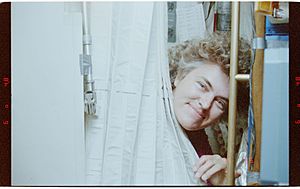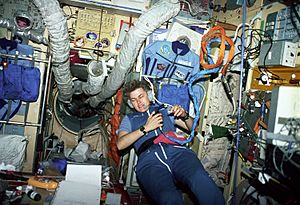Shannon Lucid facts for kids
Quick facts for kids
Shannon Lucid
|
|
|---|---|
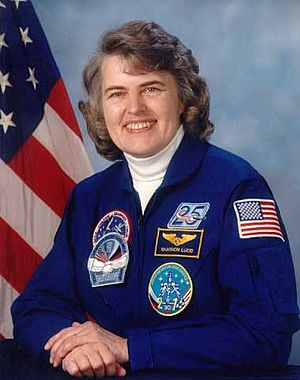
Lucid c. 2004
|
|
| Born |
Shannon Matilda Wells
January 14, 1943 Shanghai, Republic of China
|
| Awards |
|
| Space career | |
| NASA astronaut | |
|
Time in space
|
223 days, 2 hours and 50 minutes |
| Selection | NASA Group 8 (1978) |
| Missions | |
|
Mission insignia
|
|
| Scientific career | |
| Thesis | Effect of Cholera Toxin on Phosphorylation and Kinase Activity of Intestinal Epithelial Cells and Their Brush Borders (1973) |
| Doctoral advisor | Chadwick Cox |
Shannon Matilda Wells Lucid (born January 14, 1943) is an American biochemist and retired NASA astronaut. She flew into space five times. One of her most famous missions was a long stay on the Russian space station Mir in 1996. She is the only American woman to have lived on Mir.
From 1996 to 2007, Shannon Lucid held the record for the longest time an American had spent in space. She also held the record for the longest spaceflight by a woman. In December 1996, she received the Congressional Space Medal of Honor. She was the tenth person and the first woman to ever get this special award.
Shannon Lucid studied at the University of Oklahoma. She earned a bachelor's degree in chemistry in 1963. Later, she got a master's degree in biochemistry in 1970. In 1973, she completed her PhD in biochemistry. Before becoming an astronaut, she worked as a laboratory technician and a research chemist.
In 1978, NASA chose Shannon Lucid for astronaut training. She was part of NASA Astronaut Group 8, the first group of astronauts to include women. She flew on five Space Shuttle missions: STS-51-G, STS-34, STS-43, STS-58, and her long mission to Mir. For her Mir mission, she traveled there on the Space Shuttle Space Shuttle Atlantis with STS-76. She returned six months later with STS-79.
Shannon Lucid also served as the NASA Chief Scientist from 2002 to 2003. She was a capsule communicator (CAPCOM) at Mission Control. She helped guide many Space Shuttle missions, including STS-135, the very last Space Shuttle flight. Shannon Lucid retired from NASA in 2012.
Contents
Early Life and Education
Shannon Wells was born in Shanghai, China, on January 14, 1943. Her parents were missionaries. When she was just six weeks old, her family was held in an internment camp by the Japanese. They were released later that year in a prisoner exchange. The family returned to the United States.
After World War II, her family went back to China. But they left again in 1949 due to the Chinese Communist Revolution. They moved to Lubbock, Texas, and then settled in Bethany, Oklahoma. Shannon graduated from Bethany High School in 1960.
Shannon was fascinated by stories of explorers. She felt she was born too late to be an explorer on Earth. Then she learned about Robert Goddard, a famous American rocket scientist. This made her decide she could become a space explorer! She even sold her bicycle to buy a telescope to look at the stars. She also started building her own rockets.
Soon after high school, Shannon earned her private pilot's license. She could fly planes with instruments and multiple engines. She bought a small plane and used it to fly her father to meetings. She tried to get jobs as a commercial pilot, but women were not allowed to train for those jobs back then.
Shannon attended Wheaton College in Illinois, where she studied chemistry. She then moved to the University of Oklahoma. She earned her bachelor's degree in chemistry in 1963. She worked as a teaching assistant and a laboratory technician. From 1966 to 1968, she was a research chemist at Kerr-McGee, an oil company. There, she met Michael F. Lucid, another research chemist. They married in 1967.
After getting married, Shannon Lucid returned to the University of Oklahoma. She studied for her master's degree in biochemistry. She took her final exams just two days after her second daughter was born in 1970. She earned her PhD in biochemistry in 1973. Her research was about how a certain toxin affected cells. After her PhD, she worked as a research associate. Her third child was born in 1975.
Becoming a NASA Astronaut
Joining the Astronaut Team
In 1976, National Aeronautics and Space Administration (NASA) asked for people to apply to be astronauts. For the first time, women were encouraged to apply. Shannon Lucid was one of 8,079 people who applied.
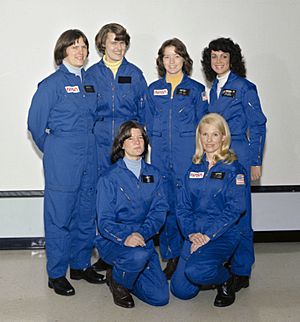
Shannon was one of 208 finalists invited to the Johnson Space Center (JSC) in Houston, Texas. She went through a week of interviews and tests in August 1977. She was in the first group of applicants that included women. On January 16, 1978, NASA announced the 35 people chosen. Six of them were women, and Shannon Lucid was the only one who was a mother at the time.
The new group of astronauts called themselves "TFNG." They trained for about 14 months. They learned about the Space Shuttle program, space flight engineering, astronomy, and how space affects the human body. They also had to complete survival training, learn to swim and scuba dive, and understand aviation safety.
By August 1979, all 35 astronaut candidates had finished their training. They were officially astronauts, ready to be chosen for space missions. Each new astronaut specialized in different parts of the Space Shuttle program. Shannon Lucid helped with training for Spacelab 1 and worked on the Hubble Space Telescope. She also helped prepare for Space Shuttle landings and takeoffs.
First Space Mission: STS-51-G
On June 17, 1985, Shannon Lucid launched into space for the first time on the Space Shuttle Space Shuttle Discovery. This mission was called STS-51-G. It was a seven-day trip.
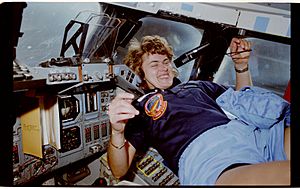
The main goal was to put three communication satellites into orbit. These satellites were for Mexico, the Arab League, and the United States. Shannon Lucid helped use the robotic arm, called the Remote Manipulator System (RMS), to release the satellites.
She also used the RMS to release a satellite called Spartan. This satellite did X-ray astronomy experiments while flying separately from the Shuttle. The crew also did other science experiments. Discovery landed back on Earth on June 24. The mission traveled about 2.9 million miles in just over one week.
Second Space Mission: STS-34
After her first flight, Shannon Lucid worked as a Capsule Communicator (CAPCOM). She was the voice from Mission Control that talked to astronauts in space. In January 1986, the Space Shuttle Challenger disaster happened. This stopped all Space Shuttle flights for 32 months.
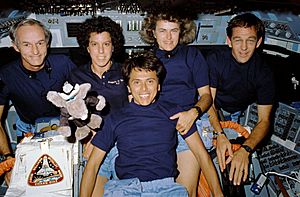
On October 18, 1989, Shannon Lucid flew on her second mission, STS-34, aboard the Space Shuttle Space Shuttle Atlantis. She was the lead mission specialist for this flight. Her main job was to deploy the Galileo spacecraft. Galileo was an unmanned probe going to Jupiter.
Shannon Lucid pressed the button to release Galileo from Atlantis. The spacecraft was successfully deployed. The mission also did other experiments, including studying how microgravity affects minerals. The crew filmed their activities with an IMAX camera. Atlantis landed on October 23.
Third Space Mission: STS-43
In August 1991, Shannon Lucid flew on her third mission, STS-43, again on the Space Shuttle Atlantis. The main goal of this mission was to deploy TDRS-E. This was a communication satellite that would help NASA track and relay data from other spacecraft.
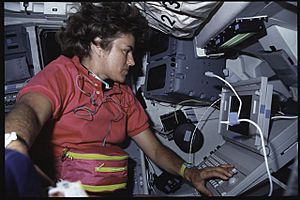
The crew successfully deployed the satellite. They also conducted 32 science experiments. These experiments looked at physics, materials, and life sciences. Many of them were related to how a future space station might work. Atlantis completed 142 orbits of Earth and landed back at Kennedy Space Center.
Fourth Space Mission: STS-58
On October 18, 1993, Shannon Lucid flew on her fourth mission, STS-58, aboard the Space Shuttle Space Shuttle Columbia. This mission was focused on studying human and animal bodies in space. It was called the Spacelab Life Sciences 2 (SLS-2) mission.
During the fourteen-day flight, the crew performed medical experiments on themselves and 48 rats. They studied how space affects bones, senses, and how people adapt to space. Shannon Lucid helped collect blood and urine samples from the crew. They also took blood from the rats to see how weightlessness affected their red blood cells.
The mission completed 225 orbits of Earth. It traveled five million miles. When this flight was over, Shannon Lucid had spent over 838 hours in space.
Living on the Mir Space Station
A Long Stay in Space
In 1992, the United States and Russia agreed to work together in space. This meant Russian cosmonauts could fly on Space Shuttles, and American astronauts could live on the Russian Mir space station. Living on Mir for a long time was a big challenge. Astronauts had to learn Russian and train in Russia for a year.
Shannon Lucid was excited about the idea of a long stay in space. She volunteered for the mission. In January 1995, she began training in Star City. On March 30, 1995, NASA announced that Shannon Lucid would be the second American astronaut to live on Mir.
Her mission to Mir began on March 22, 1996. She launched from Kennedy Space Center aboard Atlantis on the STS-76 mission. Atlantis docked with Mir on March 24. Shannon Lucid became the first American woman to live on the station. She joined two Russian cosmonauts who did not speak English.
During her time on Mir, Shannon Lucid did many science experiments. She lit candles to study fire in space. She watched how quail embryos grew in their shells. She grew protein crystals and wheat in a small greenhouse. She also studied how microgravity affected her immune system by taking blood and saliva samples.
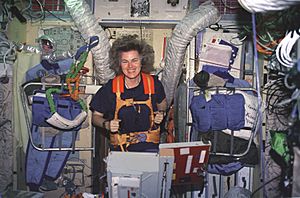
In her free time, she read books. She loved a novel called The Mirror of Her Dreams. But she only had the first part! She arranged for the second part to be sent on the next supply ship. She left her books on Mir for future astronauts. Shannon Lucid brought her own supply of M&M's and jello to eat, along with the Russian food.
Shannon Lucid returned to Earth on Atlantis with the STS-79 mission. Atlantis docked with Mir on September 18, bringing another astronaut to take her place. She landed back at Kennedy Space Center on September 26, 1996. She had spent nearly 400 hours exercising on Mir. Because of this, she was able to stand and walk off the Space Shuttle.
She received a gift of M&M's from President Bill Clinton, because she had told him she really wanted some. Shannon Lucid traveled about 75.2 million miles during her 188-day mission. This included 179 days living on Mir. Her stay was longer than planned because her return was delayed twice. She held the record for the most hours in orbit by a non-Russian and by a woman. This record was broken by Sunita Williams in 2007.
Later Career and Retirement
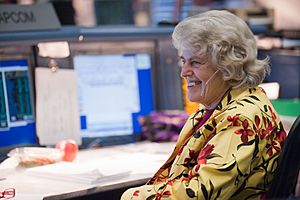
Shannon Lucid had a small part in the 1998 movie Armageddon. From 2002 to 2003, she was the NASA Chief Scientist. Starting in 2005, she was the lead CAPCOM for many Space Shuttle missions. This included STS-135, the very last Space Shuttle flight in July 2011. On January 31, 2012, she announced her retirement from NASA.
After retiring, Shannon Lucid took care of her husband, Mike, who passed away in 2014. She wrote a book about this experience. She also wrote a book about her time on Mir called Tumbleweed: Six Months Living on Mir (2020).
Awards and Honors
Shannon Lucid received the Congressional Space Medal of Honor in December 1996 for her mission to Mir. She was the tenth person and the first woman to receive this high honor.
She also received many other awards from NASA:
- NASA Space Flight Medal (six times: 1985, 1989 (twice), 1991, 1993, 1996)
- NASA Exceptional Service Medal (five times: 1988, 1990, 1992, 2003 (twice))
- NASA Distinguished Service Medal (twice: 1994, 1997)
Shannon Lucid has been honored in several halls of fame:
- International Space Hall of Fame (1990)
- Oklahoma Women's Hall of Fame (1993)
- National Women's Hall of Fame (1998)
- United States Astronaut Hall of Fame (2014)
In 2002, Discover magazine named her one of the fifty most important women in science.
See also
 In Spanish: Shannon Lucid para niños
In Spanish: Shannon Lucid para niños


